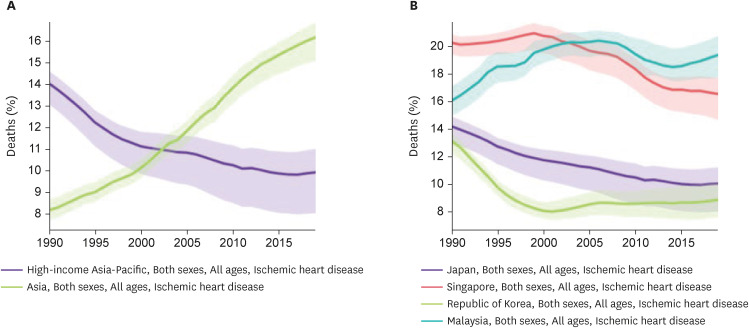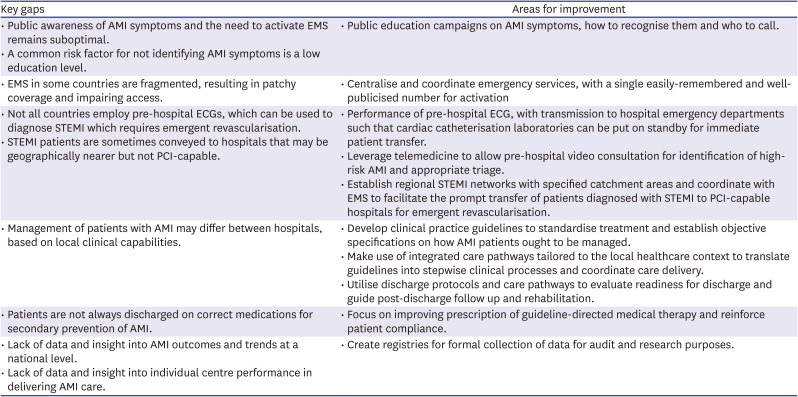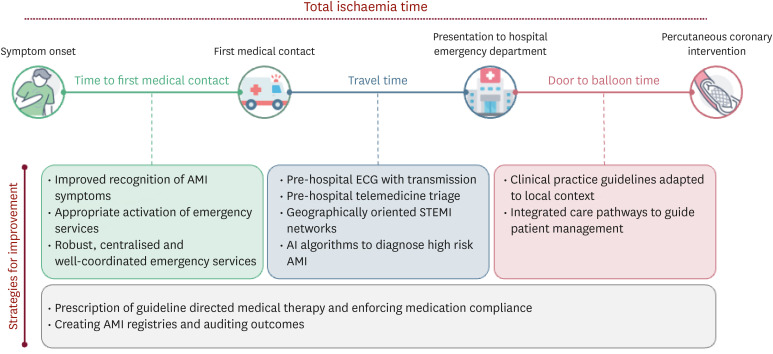1. Ohira T, Iso H. Cardiovascular disease epidemiology in Asia: an overview. Circ J. 2013; 77:1646–1652. PMID:
23803294.
2. Chan MY, Du X, Eccleston D, et al. Acute coronary syndrome in the Asia-Pacific region. Int J Cardiol. 2016; 202:861–869. PMID:
26476044.

3. GBD 2019 Risk Factors Collaborators. Global burden of 87 risk factors in 204 countries and territories, 1990-2019: a systematic analysis for the Global Burden of Disease Study 2019. Lancet. 2020; 396:1223–1249. PMID:
33069327.
4. Zhao D. Epidemiological features of cardiovascular disease in Asia. JACC Asia. 2021; 1:1–13. PMID:
36338365.

5. Jacobs AK, Antman EM, Faxon DP, Gregory T, Solis P. Development of systems of care for ST-elevation myocardial infarction patients: executive summary. Circulation. 2007; 116:217–230. PMID:
17538045.

6. Jacobs AK, Ali MJ, Best PJ, et al. Systems of care for ST-segment-elevation myocardial infarction: a policy statement from the American Heart Association. Circulation. 2021; 144:e310–e327. PMID:
34641735.
7. Gibson CM. Time is myocardium and time is outcomes. Circulation. 2001; 104:2632–2634. PMID:
11723008.

8. De Luca G, Suryapranata H, Ottervanger JP, Antman EM. Time delay to treatment and mortality in primary angioplasty for acute myocardial infarction: every minute of delay counts. Circulation. 2004; 109:1223–1225. PMID:
15007008.

9. Terkelsen CJ, Sørensen JT, Maeng M, et al. System delay and mortality among patients with STEMI treated with primary percutaneous coronary intervention. JAMA. 2010; 304:763–771. PMID:
20716739.

10. Ibanez B, James S, Agewall S, et al. 2017 ESC guidelines for the management of acute myocardial infarction in patients presenting with ST-segment elevation: the task force for the management of acute myocardial infarction in patients presenting with ST-segment elevation of the European Society of Cardiology (ESC). Eur Heart J. 2018; 39:119–177. PMID:
28886621.
11. Kim HS, Lee H, Kim K, et al. The general public’s awareness of early symptoms of and emergency responses to acute myocardial infarction and related factors in South Korea: a national public telephone survey. J Epidemiol. 2016; 26:233–241. PMID:
26853101.

12. Park KS. Factors affecting awareness of myocardial infarction symptoms among the general public in Korea. Epidemiol Health. 2020; 42:e2020032. PMID:
32512667.
13. Abdo Ahmed AA, Mohammed Al-Shami A, Jamshed S, Fata Nahas AR, Mohamed Ibrahim MI. Public awareness of and action towards heart attack symptoms: an exploratory study. Int J Environ Res Public Health. 2020; 17:8982. PMID:
33276636.

14. Quah JL, Yap S, Cheah SO, et al. Knowledge of signs and symptoms of heart attack and stroke among Singapore residents. BioMed Res Int. 2014; 2014:572425. PMID:
24812623.

15. Yonemoto N, Kada A, Yokoyama H, Nonogi H. Public awareness of the need to call emergency medical services following the onset of acute myocardial infarction and associated factors in Japan. J Int Med Res. 2018; 46:1747–1755. PMID:
29490526.

16. Sharma A, Vidusha K, Suresh H, et al. Global awareness of myocardial infarction symptoms in general population: a systematic review and meta-analysis. Korean Circ J. 2021; 51:983–996. PMID:
34595883.

17. Park YH, Kang GH, Song BG, et al. Factors related to prehospital time delay in acute ST-segment elevation myocardial infarction. J Korean Med Sci. 2012; 27:864–869. PMID:
22876051.

18. Dombrowski SU, Mackintosh JE, Sniehotta FF, et al. The impact of the UK ‘Act FAST’ stroke awareness campaign: content analysis of patients, witness and primary care clinicians’ perceptions. BMC Public Health. 2013; 13:915. PMID:
24088381.

19. Mathews R, Peterson ED, Li S, et al. Use of emergency medical service transport among patients with ST-segment-elevation myocardial infarction: findings from the National Cardiovascular Data Registry Acute Coronary Treatment Intervention Outcomes Network Registry-Get With The Guidelines. Circulation. 2011; 124:154–163. PMID:
21690494.

20. Lee SH, Kim HK, Jeong MH, et al. Pre-hospital delay and emergency medical services in acute myocardial infarction. Korean J Intern Med. 2020; 35:119–132. PMID:
31766823.

21. Ho AF, Fook-Chong S, Pek PP, Ng YY, Wong AS, Ong ME. Prehospital presentation of patients with ST-segment elevation myocardial infarction in Singapore. Int J Cardiol. 2013; 168:4273–4276. PMID:
23701931.

22. Tan LL, Wong HB, Poh CL, et al. Utilisation of emergency medical service among Singapore patients presenting with ST-segment elevation myocardial infarction: prevalence and impact on ischaemic time. Intern Med J. 2011; 41:809–814. PMID:
20546061.

23. Liu Z, Lim MJ, Pek PP, et al. Improved door-to-balloon time for primary percutaneous coronary intervention for patients conveyed via emergency ambulance service. Ann Acad Med Singapore. 2021; 50:671–678. PMID:
34625754.

24. Mohd Hassan NZ, Bahari MS, Aminuddin F, et al. Data envelopment analysis for ambulance services of different service providers in urban and rural areas in Ministry of Health Malaysia. Front Public Health. 2023; 10:959812. PMID:
36684911.

25. Ong ME, Cho J, Ma MH, et al. Comparison of emergency medical services systems in the pan-Asian resuscitation outcomes study countries: report from a literature review and survey. Emerg Med Australas. 2013; 25:55–63. PMID:
23379453.

26. Shin SD, Ong ME, Tanaka H, et al. Comparison of emergency medical services systems across Pan-Asian countries: a web-based survey. Prehosp Emerg Care. 2012; 16:477–496. PMID:
22861161.

27. O’Gara PT, Kushner FG, Ascheim DD, et al. 2013 ACCF/AHA guideline for the management of ST-elevation myocardial infarction: a report of the American College of Cardiology Foundation/American Heart Association Task Force on Practice Guidelines. J Am Coll Cardiol. 2013; 61:e78–140. PMID:
23256914.
28. Ong ME, Wong AS, Seet CM, et al. Nationwide improvement of door-to-balloon times in patients with acute ST-segment elevation myocardial infarction requiring primary percutaneous coronary intervention with out-of-hospital 12-lead ECG recording and transmission. Ann Emerg Med. 2013; 61:339–347. PMID:
23021348.

29. Ministry of Health Malaysia. National Heart Association of Malaysia. Academy of Medicine of Malaysia. Clinical Practice Guideline: Management of Acute ST-Elevation Myocardial Infarction (STEMI), 2019. 4th ed. Kuala Lumpur: National Heart Association of Malaysia;2019. cited 2023 April 3. Available from:
https://www.malaysianheart.org/?p=cpg&a=1347
.
30. Matsuzawa Y, Kosuge M, Fukui K, Suzuki H, Kimura K. Present and future status of cardiovascular emergency care system in urban areas of Japan - importance of prehospital 12-lead electrocardiogram. Circ J. 2022; 86:591–599. PMID:
34690225.

31. Cha JJ, Hong SJ. A simple protocol to save time delay for patients with ST-elevation myocardial infarction by using pre-hospital electrocardiogram transmission program. Korean Circ J. 2020; 50:720–722. PMID:
32725979.

32. Mori H, Maeda A, Akashi Y, et al. The impact of pre-hospital 12-lead electrocardiogram and first contact by cardiologist in patients with ST-elevation myocardial infarction in Kanagawa, Japan. J Cardiol. 2021; 78:183–192. PMID:
33926761.

33. Takeuchi I, Fujita H, Yanagisawa T, et al. Impact of doctor car with mobile cloud ECG in reducing door-to- balloon time of Japanese ST-elevation myocardial infarction patients. Int Heart J. 2015; 56:170–173. PMID:
25740577.

34. Rahme RJ, Fishman AJ, Hunt Batjer H, Bendok BR. The future is now: smartphones to join scalpels and stethoscopes? Neurosurgery. 2012; 70:N19–N20.
35. Magimel-Pelonnier E, Marjanovic N, Couvreur R, Drugeon B, Mimoz O, Guenezan J. Photography tele-transmission by regular ambulance staff for the management of mild traumatic injury: the NiCEPHORE randomised-controlled trial. Scand J Trauma Resusc Emerg Med. 2022; 30:53. PMID:
36242052.

36. Takano T, Ida T, Tanaka K, Obayashi K, Kimura E. Prehospital care (CCU network) of acute myocardial infarction and treatment of cardiogenic shock by intra-aortic balloon pumping. Jpn Circ J. 1981; 45:623–635. PMID:
7230513.

37. Yusof TN, Liu KT, Kasim S. Impact of a regional STEMI network on patient outcomes in Malaysia. Int J Cardiol. 2019; 297:16. PMID:
31839197.

38. Alexander T, Victor SM, Mullasari AS, et al. Protocol for a prospective, controlled study of assertive and timely reperfusion for patients with ST-segment elevation myocardial infarction in Tamil Nadu: the TN-STEMI programme. BMJ Open. 2013; 3:e003850.

39. Zhang Y, Yu B, Han Y, et al. Protocol of the China ST-Segment Elevation Myocardial Infarction (STEMI) Care Project (CSCAP): a 10-year project to improve quality of care by building up a regional STEMI care network. BMJ Open. 2019; 9:e026362.

40. Wang JM, Kim BO, Bae JW, Oh DJ. Implementation of national health policy for the prevention and control of cardiovascular disease in South Korea: regional-local cardio-cerebrovascular center and nationwide registry. Korean Circ J. 2021; 51:383–398. PMID:
33975386.

41. Takeda M, Oami T, Hayashi Y, et al. Prehospital diagnostic algorithm for acute coronary syndrome using machine learning: a prospective observational study. Sci Rep. 2022; 12:14593. PMID:
36028534.

42. Choi A, Kim MJ, Sung JM, et al. Development of prediction models for acute myocardial infarction at prehospital stage with machine learning based on a nationwide database. J Cardiovasc Dev Dis. 2022; 9:430. PMID:
36547427.

43. Chen KW, Wang YC, Liu MH, et al. Artificial intelligence-assisted remote detection of ST-elevation myocardial infarction using a mini-12-lead electrocardiogram device in prehospital ambulance care. Front Cardiovasc Med. 2022; 9:1001982. PMID:
36312246.

44. Jacobsen L, Grenne B, Olsen RB, Jortveit J. Feasibility of prehospital identification of non-ST-elevation myocardial infarction by ECG, troponin and echocardiography. Emerg Med J. 2022; 39:679–684. PMID:
35064012.

45. Ministry of Health Malaysia. National Heart Association of Malaysia. Academy of Medicine of Malaysia. Clinical Practice Guideline: Management of Non-ST Elevation Myocardial Infarction (NSTE-ACS), 2021. 3rd ed. Kuala Lumpur: National Heart Association of Malaysia;2021. cited 2023 April 3. Available from:
https://www.malaysianheart.org/?p=cpg&a=1687
.
46. Kimura K, Kimura T, Ishihara M, et al. JCS 2018 guideline on diagnosis and treatment of acute coronary syndrome. Circ J. 2019; 83:1085–1196. PMID:
30930428.

47. Kim HK, Ahn Y, Chang K, et al. 2020 Korean Society of Myocardial Infarction expert consensus document on pharmacotherapy for acute myocardial infarction. Korean Circ J. 2020; 50:845–866. PMID:
32969206.

48. Chang K, Ahn Y, Lim S, et al. 2021 Korean Society of Myocardial Infarction expert consensus document on revascularization for acute myocardial infarction. Korean Circ J. 2021; 51:289–307. PMID:
33821579.

49. Daghash H, Lim Abdullah K, Ismail MD. The effect of acute coronary syndrome care pathways on in-hospital patients: a systematic review. J Eval Clin Pract. 2020; 26:1280–1291. PMID:
31489762.

50. Nakamura I, Hori S, Suzuki M, et al. Critical pathway improves arrival-in-cath-lab interval for patients with acute myocardial infarction in the emergency department. Jpn Circ J. 2001; 65:849–852. PMID:
11665786.

51. Cheah J. Clinical pathways--an evaluation of its impact on the quality of care in an acute care general hospital in Singapore. Singapore Med J. 2000; 41:335–346. PMID:
11026801.
52. Park YS, Chung SP, You JS, et al. Effectiveness of a multidisciplinary critical pathway based on a computerised physician order entry system for ST-segment elevation myocardial infarction management in the emergency department: a retrospective observational study. BMJ Open. 2016; 6:e011429.

53. Hai JJ, Wong CK, Un KC, et al. Guideline-based critical care pathway improves long-term clinical outcomes in patients with acute coronary syndrome. Sci Rep. 2019; 9:16814. PMID:
31728003.

54. Ahmed T, Paracha MY, Khan B, et al. Impact of AMI standard clinical pathway on clinical outcomes in the management of acute myocardial infarction patient in a public tertiary care hospital, Karachi-Pakistan. Ann Med Health Sci Res. 2021; 11:80–87.
55. Rathod KS, Comer K, Casey-Gillman O, et al. Early hospital discharge following PCI for patients with STEMI. J Am Coll Cardiol. 2021; 78:2550–2560. PMID:
34915986.

56. Arakawa T, Kumasaka L, Nakanishi M, et al. Regional clinical alliance path and cardiac rehabilitation after hospital discharge for acute myocardial infarction patients in Japan - a nationwide survey. Circ J. 2016; 80:1750–1755. PMID:
27357332.

57. Dalal JJ, Krittayaphong R, Nicholls SJ, Soomro K, Yeo KK. Consensus recommendations of the Asia Pacific Cardiometabolic Consortium on secondary prevention strategies in myocardial infarction: recommendations on pharmacotherapy, lifestyle modification and cardiac rehabilitation. J Asian Pac Soc Cardiol. 2023; 2:e01.

58. Tern PJW, Ho AKH, Sultana R, et al. Comparative overview of ST-elevation myocardial infarction epidemiology, demographics, management, and outcomes in five Asia-Pacific countries: a meta-analysis. Eur Heart J Qual Care Clin Outcomes. 2021; 7:6–17. PMID:
32584986.

59. Kim Y, Ahn Y, Cho MC, Kim CJ, Kim YJ, Jeong MH. Current status of acute myocardial infarction in Korea. Korean J Intern Med. 2019; 34:1–10. PMID:
30612415.

60. Nakao K, Yasuda S, Nishimura K, et al. Prescription Rates of guideline-directed medications are associated with in-hospital mortality among Japanese patients with acute myocardial infarction: a report from JROAD - DPC study. J Am Heart Assoc. 2019; 8:e009692. PMID:
30909774.

61. Singapore Myocardial Infarction Registry. Trends in Acute Myocardial Infarction in Singapore 2007–2013. Singapore: National Registry of Diseases Office;2013.
62. Kim JH, Chae SC, Oh DJ, et al. Multicenter cohort study of acute myocardial infarction in Korea - interim analysis of the Korea Acute Myocardial Infarction Registry-National Institutes of Health Registry. Circ J. 2016; 80:1427–1436. PMID:
27118621.

63. Daida H, Miyauchi K, Ogawa H, et al. Management and two-year long-term clinical outcome of acute coronary syndrome in Japan: prevention of atherothrombotic incidents following ischemic coronary attack (PACIFIC) registry. Circ J. 2013; 77:934–943. PMID:
23502993.

64. Venkatason P, Zubairi YZ, Hafidz I, Wan WA, Zuhdi AS. Trends in evidence-based treatment and mortality for ST elevation myocardial infarction in Malaysia from 2006 to 2013: time for real change. Ann Saudi Med. 2016; 36:184–189. PMID:
27236389.

65. Venkatason P, Zaharan NL, Ismail MD, Wan Ahmad WA, Mahmood Zuhdi AS. Trends and variations in the prescribing of secondary preventative cardiovascular therapies for non-ST elevation myocardial infarction (NSTEMI) in Malaysia. Eur J Clin Pharmacol. 2018; 74:953–960. PMID:
29582106.

66. Byeon HJ, Yang YM, Choi EJ. Optimal medical therapy for secondary prevention after an acute coronary syndrome: 18-month follow-up results at a tertiary teaching hospital in South Korea. Ther Clin Risk Manag. 2016; 12:167–175. PMID:
26929629.
67. Tam LM, Fonarow GC, Bhatt DL, et al. Achievement of guideline-concordant care and in-hospital outcomes in patients with coronary artery disease in teaching and nonteaching hospitals: results from the Get With The Guidelines-Coronary Artery Disease program. Circ Cardiovasc Qual Outcomes. 2013; 6:58–65. PMID:
23233750.

68. Kim RB, Hwang JY, Park HW, et al. Contemporary status of acute myocardial infarction in Korean patients: Korean Registry of Acute Myocardial Infarction for Regional Cardiocerebrovascular Centers. J Clin Med. 2021; 10:498. PMID:
33535380.

69. Honda S, Nishihira K, Kojima S, et al. Rationale, design, and baseline characteristics of the prospective Japan Acute Myocardial Infarction Registry (JAMIR). Cardiovasc Drugs Ther. 2019; 33:97–103. PMID:
30470946.

70. Miyachi H, Yamamoto T, Takayama M, et al. 10-Year temporal trends of in-hospital mortality and emergency percutaneous coronary intervention for acute myocardial infarction. JACC Asia. 2022; 2:677–688. PMID:
36444314.

71. Chin SP, Jeyaindran S, Azhari R, et al. Acute coronary syndrome (ACS) registry - leading the charge for National Cardiovascular Disease (NCVD) Database. Med J Malaysia. 2008; 63(Suppl C):29–36.
72. Srimahachota S, Kanjanavanit R, Boonyaratavej S, et al. Demographic, management practices and in-hospital outcomes of Thai Acute Coronary Syndrome Registry (TACSR): the difference from the Western world. J Med Assoc Thai. 2007; 90(Suppl 1):1–11.
73. Bi Y, Gao R, Patel A, et al. Evidence-based medication use among Chinese patients with acute coronary syndromes at the time of hospital discharge and 1 year after hospitalization: results from the Clinical Pathways for Acute Coronary Syndromes in China (CPACS) study. Am Heart J. 2009; 157:509–516.e1. PMID:
19249422.

74. Liu KT, Lee SWH, Selvaraj SG, et al. An update on acute coronary syndrome and myocardial infarction registries among member countries of the Asian Pacific Society of Cardiology. J Asian Pac Soc Cardiol. 2022; 1:e27.

75. Kim HK, Jeong MH, Lee SH, et al. The scientific achievements of the decades in Korean Acute Myocardial Infarction Registry. Korean J Intern Med. 2014; 29:703–712. PMID:
25378967.

76. Jollis JG, Al-Khalidi HR, Roettig ML, et al. Impact of regionalization of ST-segment-elevation myocardial infarction care on treatment times and outcomes for emergency medical services-transported patients presenting to hospitals with percutaneous coronary intervention: mission: lifeline accelerator-2. Circulation. 2018; 137:376–387. PMID:
29138292.







 PDF
PDF Citation
Citation Print
Print




 XML Download
XML Download